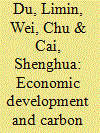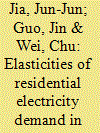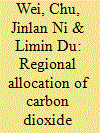|
|
|
Sort Order |
|
|
|
Items / Page
|
|
|
|
|
|
|
| Srl | Item |
| 1 |
ID:
136208


|
|
|
|
|
| Summary/Abstract |
A comprehensive survey of 1450 households in 26 Chinese provinces was undertaken in 2012 to identify the characteristics and potential driving forces of residential energy consumption in China. The survey covers six areas: household characteristics, dwelling characteristics, kitchen and home appliances, space heating and cooling, residential transportation, and electricity billing, metering, and pricing options. The results show that a typical Chinese household in 2012 consumed 1426 kilograms standard coal equivalent, which is approximately 44 percent of the 2009 level in the United States and 38 percent of the 2008 level in the EU-27. District heating, natural gas, and electricity are three major residential energy sources, while space heating, cooking, and water heating are three major end-use activities. Moreover, the results suggest a large urban–rural gap in terms of energy sources and purpose of usage. Commercial energy is used mainly for space heating in urban areas, while biomass dominates mainly for cooking purpose in rural areas. The survey results can help decision makers and scholars identify energy conservation opportunities, and evaluate the effectiveness of energy policies.
|
|
|
|
|
|
|
|
|
|
|
|
|
|
|
|
| 2 |
ID:
195045


|
|
|
|
|
| Summary/Abstract |
This editorial establishes the context for our special issue, devoted to exploring CO2 allocation and equity considerations within the framework of China's ambitions for carbon neutrality. As the world's largest greenhouse gas emitter, China has made a pivotal development in mitigating climate change efforts with its commitment to achieving carbon neutrality by 2060. This collection of 16 diverse papers delves into recent advancements, challenges, and thematic explorations related to carbon dioxide emissions, providing a holistic analysis of the allocation mechanisms and the critical balance between equity and efficiency. The contributions, which span a wide range of disciplines, collectively reveal the nuances of integrating economic growth, social justice, and environmental stewardship in China's transition to a sustainable, low-carbon future. The editorial not only synthesizes the key insights from the included papers but also frames the overarching narrative, highlighting the significance of collaborative and equitable approaches in achieving China's carbon neutrality targets.
|
|
|
|
|
|
|
|
|
|
|
|
|
|
|
|
| 3 |
ID:
112726


|
|
|
|
|
| Publication |
2012.
|
| Summary/Abstract |
This paper investigates the driving forces, emission trends and reduction potential of China's carbon dioxide (CO2) emissions based on a provincial panel data set covering the years 1995 to 2009. A series of static and dynamic panel data models are estimated, and then an optimal forecasting model selected by out-of-sample criteria is used to forecast the emission trend and reduction potential up to 2020. The estimation results show that economic development, technology progress and industry structure are the most important factors affecting China's CO2 emissions, while the impacts of energy consumption structure, trade openness and urbanization level are negligible. The inverted U-shaped relationship between per capita CO2 emissions and economic development level is not strongly supported by the estimation results. The impact of capital adjustment speed is significant. Scenario simulations further show that per capita and aggregate CO2 emissions of China will increase continuously up to 2020 under any of the three scenarios developed in this study, but the reduction potential is large.
|
|
|
|
|
|
|
|
|
|
|
|
|
|
|
|
| 4 |
ID:
179683


|
|
|
|
|
| Summary/Abstract |
China has implemented the residential increasing-block electricity pricing (IBEP) policy since the second half of 2012, which is considered the most effective economic instrument in improving residential energy efficiency. Price and income elasticity are two fundamental parameters to guide both scholars and policy-makers in assessing whether and to what extend Chinese households respond to the policy. However, it presents the challenge of simultaneous determination of marginal price and electricity consumption; further, it is less examined from an empirical perspective due to the absence of micro-level data. To fill this gap, this study estimates price and income elasticity by establishing two instrumental variables, based on a unique dataset from the Chinese Residential Energy Consumption Survey 2014. Results show that the residential demand for electricity is price inelastic and that electricity is an essential commodity for households in the short run. It also shows great urban-rural disparity and regional heterogeneity of household electricity consumption behavior regarding short-run income elasticity. The estimated parameters of short-run price and income elasticities provide a valuable reference for policy-making regarding both a nationwide uniform and a differential regional perspective.
|
|
|
|
|
|
|
|
|
|
|
|
|
|
|
|
| 5 |
ID:
090940


|
|
|
|
|
| Publication |
2009.
|
| Summary/Abstract |
This paper proposes an energy efficiency index based on the data envelopment analysis approach. The index is used to examine energy efficiency in China. Using 1997-2006 panel data for 29 provinces, we find that energy efficiency is negatively associated with the secondary industry share in GDP, the state-owned economic share in GDP and the government expenditure share in GDP, and is positively associated with the technical level and non-coal share in energy consumption. In addition, we find that there exists a large gap in energy efficiency among eastern, central and western regions. The eastern region has a significantly higher energy efficiency level than the central and western regions. We conclude that the different levels of industry structure, government intervention, energy structure, and the technology content in the three regions lead to the differences in energy efficiency.
|
|
|
|
|
|
|
|
|
|
|
|
|
|
|
|
| 6 |
ID:
128152


|
|
|
|
|
| Publication |
2012.
|
| Summary/Abstract |
This paper aims to identify which provinces will be allocated more (less) of a carbon dioxide reduction burden within China's pledge to reduce its carbon intensity at the Copenhagen conference. Using an extended Slacks-Based Measure (SBM) model incorporating an undesirable output, the CO2 reduction potential and marginal abatement costs are estimated for 29 provinces over the period 1995-2007. The CO2 Abatement Capacity Index (ACI) is constructed based on weighted equity and efficiency indexes. We find that there exists a large gap in potential reduction capability and marginal abatement cost among the eastern, middle and western regions. The eastern region has the least inefficient emission and the highest marginal abatement cost, while the western region has the largest potential reduction capability and the lowest marginal cost faced in reducing CO2 emissions. The difference in potential CO2 abatement among the provinces results from different industry structures, energy compositions and degrees of the openness of trade. The ACI ranking and the final allocation among provinces depend on the policy-makers' preferences regarding equity and efficiency.
|
|
|
|
|
|
|
|
|
|
|
|
|
|
|
|
| 7 |
ID:
097255


|
|
|
|
|
| Publication |
2010.
|
| Summary/Abstract |
This paper investigates the relationship between the world oil price and China's macro-economy based on a monthly time series from 1995:1 to 2008:12, using the method of multivariate vector autoregression (VAR). The results show that the world oil price affects the economic growth and inflation of China significantly, and the impact is non-linear. On the other hand, China's economic activity fails to affect the world oil price, which means that the world oil price is still exogenous with respect to China's macro-economy in time series sense, and China has not yet had an oil pricing power in the world oil markets. The structural stability tests demonstrate that there is a structural break in the VAR model because of the reforms of China's oil pricing mechanism, thus it is more appropriate to break the whole sample into different sub-samples for the estimation of the model.
|
|
|
|
|
|
|
|
|
|
|
|
|
|
|
|
|
|
|
|
|